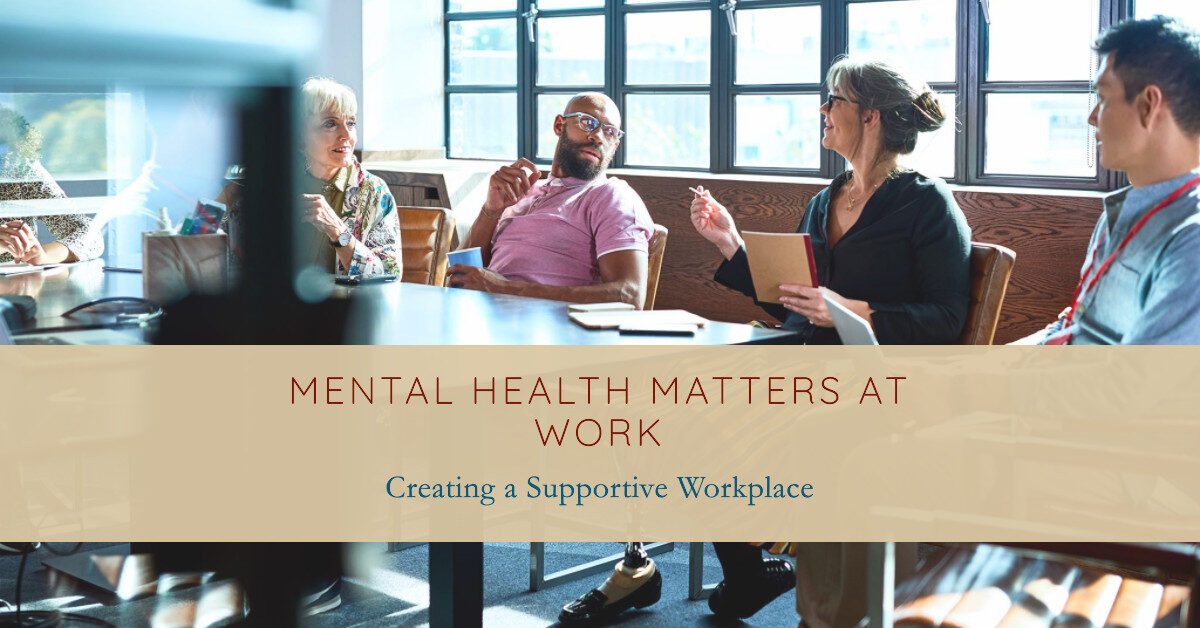Imagine a workplace bustling with activity; colleagues exchanging ideas, managers guiding their teams, and tasks being ticked off lists. Now, picture a parallel scene, where beneath the surface, anxiety brews, burnout spreads like wildfire, and silence suffocates those struggling. Mental health is the silent engine of every workplace. It is invisible, yet its impact ripples through every meeting, every email, and every interaction.

For decades, workplace mental health was whispered about, hidden behind HR processes and avoided at leadership tables. Today, the understanding, the stigma, is shifting, but the question remains: Is it enough?
The UK’s workforce faces a mental health crisis. In 2023, an estimated 15% of employees lived with a mental health condition (many equate this to the Covid Pandemic, me personally – I think it has always been there, in the background, but is now statistically measured), and the effects on productivity, retention, and overall organisational health are undeniable. Mental health concerns are no longer silent issues, they are front and centre of workplace sustainability. Statistics show that poor mental health costs UK organisations between £42 billion and £45 billion annually in absenteeism, presenteeism (working while unwell), and staff turnover.
Beyond the numbers lies a deeper truth:
Workplaces are where many spend the majority of their waking hours (for many it can be anywhere from 25% to 50% of a normal day – if not longer!). They are environments that can either uplift or break individuals.
Every organisation holds the power to create spaces where people are not just employed but supported, where their well-being is nurtured alongside their professional growth.
Why Address Mental Health Now?
The urgency to address mental health has never been more critical. Post-pandemic workplaces are reshaping themselves. Hybrid models, economic uncertainties, and increasing demands for productivity have left employees navigating uncharted waters. For some, the isolation of remote work has led to heightened feelings of loneliness; for others, the pressure to excel in a competitive market is relentless.
Workplace mental health is not just an individual issue, it is a society challenge that requires a joint responsibility. Employers have a unique opportunity to make a difference, not as a moral obligation alone, but as a strategic advantage. Research confirms that organisations prioritising mental health report higher employee engagement, improved retention rates, and greater overall performance. It is not a matter of “if” businesses should act but “how soon.“
The Culture Shift from Reactive to Proactive
 Historically, mental health in the workplace has been treated as reactive. Employees were offered support only after reaching breaking points; when absenteeism became unmanageable or performance drastically declined. This approach is no longer sufficient. Organisations must shift towards proactive strategies: embracing cultures where mental health is prioritised before a crisis appears.
Historically, mental health in the workplace has been treated as reactive. Employees were offered support only after reaching breaking points; when absenteeism became unmanageable or performance drastically declined. This approach is no longer sufficient. Organisations must shift towards proactive strategies: embracing cultures where mental health is prioritised before a crisis appears.
This cultural transformation starts with leadership. Leaders set the tone, and when they openly address and prioritise mental health, it becomes an organisational value rather than an afterthought. The workplace of the future is one where mental health is seen not as a barrier to productivity but as a bridge to it. Organisations that invest in their people’s well-being are not only ethically aligned with the times but are also creating robust foundations for growth, innovation, and sustainability.
The essential challenge is clear: It is time for workplaces to evolve into safe havens where mental health thrives alongside professional achievement. By embracing this shift, businesses can rewrite the narrative, transforming from environments of silent suffering into ones of shared strength and resilience.
A Shared Responsibility: From the Boardroom to the Breakroom
Mental health is not confined to HR policies or wellness initiatives. It is integrated into every layer of the workplace, and the responsibility for empowering a mentally healthy environment belongs to everyone, regardless of their role or title.
Colleagues are often the first to notice when someone is struggling. Working alongside each other day in and day out builds familiarity. Colleagues recognise changes in behaviour; withdrawn conversations, subtle disengagement, or uncharacteristic stress; often long before a manager does. This is where leadership knows no bounds. Leadership emerges not from hierarchy but from action:
- A colleague offering to grab a coffee with someone who seems down.
- Checking in quietly.
- Suggesting a chat with a Mental Health First Aider (MHFA).
It is important to understand that mental health and trust often intersect here. Many employees feel safer confiding in a peer they trust rather than escalating concerns to a manager. In some workplaces, the stigma surrounding “going to the manager” remains strong, and trust with leadership can take time to build. By fostering a culture where colleagues are empowered to care for one another, organisations can reduce the barrier to seeking help.
 This doesn’t negate the role of managers, but it reframes it. While managers may not always be the first to notice struggles, their responsibility lies in creating an environment of openness and support. Managers need to listen, act with compassion, and remain approachable, not distant figures who step away from the team, but active participants in its well-being.
This doesn’t negate the role of managers, but it reframes it. While managers may not always be the first to notice struggles, their responsibility lies in creating an environment of openness and support. Managers need to listen, act with compassion, and remain approachable, not distant figures who step away from the team, but active participants in its well-being.
Leadership, however, extends far beyond managerial roles. A leader can be anyone at any level. They are the ones who inspire trust through action, empathy, and authenticity. A leader is the colleague who takes responsibility for noticing when something is off, speaks up, or steps in to make someone feel supported. In workplaces where trust is prioritised over hierarchy, leadership flourishes.
Food for Thought
It is essential to challenge the misconception that mental health struggles are confined to certain roles. Anyone from the new starter to the CEO can experience mental health issues. When organisations embrace the idea that mental health is a whole organisation responsibility, they redefine success. It is not just about metrics or output, but about creating an environment where every individual feels valued, respected, and supported.
Imagine a workplace where every single employee carries the same title and has equal responsibility for looking out for one another. Without hierarchy, leadership emerges naturally, built on trust and shared purpose. This is the future we should all be striving for where mental health isn’t someone else’s job but everyone’s commitment.
Current State of Mental Health in UK Workplaces (2020–2024)
Over the past five years, the mental health landscape in UK workplaces has undergone significant changes, influenced by factors such as the COVID-19 pandemic, economic uncertainties, and evolving work environments. Below is an overview of key statistics from January 2020 to December 2024:
Key Statistics (2020–2024)

Sources: HSE Statistics, Deloitte Report
Insights from the Data
- Prevalence of Mental Health Issues 2020–2021: The onset of the COVID-19 pandemic led to a notable increase in work-related mental health cases, rising from approximately 828,000 in 2020 to 875,000 in 2021. This surge was attributed to factors such as remote working challenges, health anxieties, and economic uncertainties.
2022–2023: The number of reported cases remained steady at 875,000 in 2022. However, 2023 saw a decrease to 776,000 cases, possibly due to increased mental health awareness and the implementation of supportive workplace initiatives. - Impact on Productivity 2020–2021: Working days lost due to mental health issues decreased slightly from 17.9 million in 2020 to 17.1 million in 2021.
2022–2023: The figure remained constant at 17.1 million days in 2022 but declined to 16.4 million days in 2023, indicating a positive trend towards improved mental health management in workplaces. - Economic Implications 2020–2021: The financial burden on UK employers due to poor mental health was estimated at £45 billion in 2020, increasing to £51 billion in 2021.
2022–2023: The cost remained at £51 billion in 2022, with data for 2023 pending. This sustained financial impact underscores the need for continued investment in mental health support.
Understanding the Trends
The data from 2020 to 2024 highlights the dynamic nature of workplace mental health in the UK. The initial increase in mental health issues during the pandemic reflects the challenges faced by employees adapting to unprecedented changes. The subsequent decrease in reported cases and working days lost suggests that efforts to address mental health are bringing positive results. However, the consistent economic burden indicates that there is still significant work to be done.
By examining these trends, organisations can better understand the evolving mental health landscape and the importance of sustained, proactive measures to support employee well-being. Continuous investment in mental health initiatives is not only a moral imperative but also a strategic necessity for long-term organisational success.
The Impact of Evolving AI Technology on Mental Health in Workplaces
 As organisations increasingly adopt Artificial Intelligence (AI) technologies, the workplace dynamic is undergoing a transformation that will undoubtedly affect the mental health of employees. While the long-term effects remain speculative, several emerging trends and potential impacts can be identified based on current developments.
As organisations increasingly adopt Artificial Intelligence (AI) technologies, the workplace dynamic is undergoing a transformation that will undoubtedly affect the mental health of employees. While the long-term effects remain speculative, several emerging trends and potential impacts can be identified based on current developments.
Potential Positive Impacts on Mental Health
- Reduction in Repetitive Tasks: AI-powered tools can automate mundane and repetitive tasks, reducing employee workloads and freeing up time for more meaningful work. This shift could alleviate stress and improve job satisfaction, especially for roles traditionally burdened by administrative tasks.
- Enhanced Mental Health Support: AI-driven mental health applications, such as chatbots or virtual counsellors, can provide immediate support to employees. Tools like Wysa, Woebot, and others use natural language processing to offer confidential, real-time support. These tools could make mental health resources more accessible, especially in organisations with limited human resources for such support.
- Improved Personalisation: AI can analyse employee behaviour and feedback to create personalised mental health support options. For example, AI might identify burnout risk by analysing patterns such as long working hours or decreased productivity and recommend tailored solutions, like scheduling breaks or reducing workloads.
Potential Negative Impacts on Mental Health
- Job Insecurity: One of the most significant concerns is the potential for AI to replace human roles, leading to heightened job insecurity. Employees in roles vulnerable to automation may experience increased anxiety about their future, even if immediate redundancies are not planned.
- Always-On Culture: AI-enabled productivity tools, while efficient, can inadvertently contribute to an always-on culture. The ease of completing tasks outside of traditional working hours could blur work-life boundaries, leading to burnout.
- Increased Monitoring and Pressure: AI monitoring tools designed to track productivity or engagement could lead to a perception of micromanagement. Employees might feel scrutinised, eroding trust and increasing workplace stress.
Forecasting the Impact on Workplace Mental Health
Given the rapid integration of AI into workplace systems, the following trends may emerge over the next two years:

Statistical Projection
- AI-Driven Job Insecurity: Approximately 35% of employees in industries such as finance, customer service, administration, and manufacturing may feel threatened by AI automation by 2025. This fear could lead to a measurable increase in stress-related illnesses.
- Adoption of AI Mental Health Tools: By the end of 2025, up to 25% of UK workplaces are expected to implement AI-based mental health tools. While this could provide support for up to 5 million employees, its effectiveness will depend on how well these tools are integrated with human support systems.
- Workplace Burnout Risk: The rise of AI productivity tools could contribute to a 10–15% increase in reported cases of burnout if organisations fail to establish boundaries for their use.
Balancing the Benefits and Risks
While AI offers transformative potential, its implementation must be accompanied by thoughtful strategies to mitigate risks to mental health:
- Transparency and Communication: Employers should be transparent about how AI is used, particularly in monitoring or automation, to reduce employee anxiety.
- Integration with Human Support: AI tools should complement, not replace, human interactions. While AI can provide immediate support, employees must still have access to trained mental health professionals.
- Ethical Use of Data: Organisations must ensure that AI systems respect employee privacy and use data responsibly. Trust in these systems is essential to their success.
Something to think about?
 The integration of AI into workplaces presents a dual-edged sword for mental health. On one hand, it offers opportunities to reduce stress, personalise support, and streamline workloads. On the other, it raises concerns about job security, work-life balance, and monitoring.
The integration of AI into workplaces presents a dual-edged sword for mental health. On one hand, it offers opportunities to reduce stress, personalise support, and streamline workloads. On the other, it raises concerns about job security, work-life balance, and monitoring.
Over the next two years, the impact of AI on workplace mental health will depend heavily on how organisations navigate this transition. By prioritising ethical implementation and maintaining a human-centred approach, AI has the potential to support rather than undermine employee well-being.
Key Components of a Mental Health at Work Plan
Building a robust and effective mental health at work plan is not merely a procedural exercise; it is a foundational step in creating a workplace culture that values and protects the well-being of its employees. A well-constructed plan is proactive, inclusive, and actionable, addressing mental health challenges with clarity and compassion. Below are the key components that every organisation should consider when designing such a plan.
Summary of Key Components

Leadership Commitment
- Define Organisational Values: Mental health must be positioned as a core value within the organisation. Leadership must publicly commit to prioritising employee well-being and embedding it into organisational goals.
- Develop a Mental Health Policy: This policy should outline the organisation’s commitment to mental health, including clear objectives, resources, and expectations for employees and leaders alike. It should include: Anti-stigma campaigns to normalise conversations about mental health. Zero-tolerance policies for discrimination related to mental health conditions. A framework for reporting and addressing mental health concerns.
Open Communication
- Encourage Conversations: Organisations must create a culture where employees feel safe discussing mental health without fear of judgment or reprisal. This can include: Regular mental health check-ins as part of team meetings. Anonymous feedback channels to gather employee concerns.
- Training for Managers and Teams: Train managers and team leaders to identify mental health issues, hold sensitive conversations, and provide initial support. This training should extend to employees, empowering them to support colleagues.
Support Systems
- Mental Health First Aiders (MHFA): Establish a network of trained Mental Health First Aiders within the organisation to offer immediate support and guidance to employees in need.
- Employee Assistance Programmes (EAPs): Provide access to confidential counselling, legal advice, and financial support services to address the holistic needs of employees.
- 24/7 Digital Tools and Resources: Introduce AI-driven mental health apps and tools that offer self-guided support and crisis resources. Examples include mindfulness apps and anonymous chatbots for stress management.
Work-Life Balance
- Flexible Working Arrangements: Offer hybrid or remote work options where feasible, enabling employees to balance personal and professional responsibilities.
- Enforceable Boundaries: Encourage employees to disconnect outside working hours and establish policies against excessive overtime.
- Encourage Time Off: Promote the use of mental health days and annual leave, ensuring employees have time to recharge and avoid burnout.
Training and Education
- Workplace Mental Health Workshops: Host regular workshops or webinars on stress management, resilience building, and coping strategies.
- Role-Specific Training: Equip managers and HR teams with specialised training to handle mental health-related conversations and concerns effectively.
- Employee Awareness Campaigns: Educate employees about recognising the signs of mental health issues in themselves and others, reducing stigma and building a supportive workplace.
Monitoring and Improvement
- Regular Assessments: Conduct periodic surveys and assessments to gauge the effectiveness of mental health initiatives and identify areas for improvement. Key areas to evaluate include: Employee satisfaction and engagement. Absenteeism and presenteeism trends. Utilisation of mental health resources.
- Feedback Mechanisms: Create open channels for employees to share their thoughts on current mental health practices, allowing for continuous adaptation and enhancement.
- Track Metrics: Use data-driven insights to measure the impact of the mental health plan. Metrics such as reduced absenteeism, higher engagement scores, and improved retention rates are critical indicators of success.
Inclusivity and Customisation
- Cultural Sensitivity: Recognise that mental health perceptions and challenges vary across cultures. Customise mental health strategies to reflect the diversity of your workforce.
- Tailored Support: Adapt mental health resources to suit different roles, workloads, and individual needs within the organisation. For instance, frontline workers may require distinct resources compared to office-based employees.

A comprehensive mental health at work plan is the cornerstone of a thriving workplace. By addressing these key components, organisations can foster a culture of care, resilience, and productivity. It’s not just about reacting to challenges but proactively creating an environment where every individual feels supported and valued.
Implementing Mental Health Support Initiatives
Introducing support initiatives for mental health in the workplace is not a one-off strategy; it requires sustained effort, continuous communication, and regular reinforcement to ensure lasting impact. A mental health framework that is neglected after its initial launch risks losing momentum and failing to achieve its objectives. To create meaningful change, support initiatives must be an essential part of the workplace culture and revisited/reviewed frequently. Below is my personal opinion of what the guide to implementing and maintaining mental health support initiatives should include.
Frequency of Initiatives

Mental Health Awareness Campaigns
Mental health awareness is not a box-ticking exercise. By keeping the conversation alive and ongoing, organisations can break down stigma and normalise discussions around mental health.
- Monthly Well-Being Campaigns: Host monthly campaigns addressing specific mental health topics, such as stress management in January (post-holiday burnout), work-life balance in April, and mindfulness in October (World Mental Health Day).
- Quarterly Mental Health Newsletters: Send out newsletters featuring tips, resources, and real stories of resilience from within the organisation (with employee consent) to keep mental health top of mind.
- Annual Mental Health Awareness Week: Align internal initiatives with national or international events, such as Mental Health Awareness Week in May, to spotlight organisational commitment and engage employees.
Training and Education
Frequent and consistent training ensures employees and leaders have the tools to address mental health challenges effectively.
- Frequency of Training: Mental Health First Aider (MHFA) Training: Review MHFA certifications and retrain every three years (certification valid length) to ensure updated knowledge and confidence in handling issues. Managerial Training: Schedule twice-yearly training for managers on how to identify signs of mental health struggles and provide appropriate support. Employee Workshops: Host quarterly workshops for all employees on topics like mindfulness, resilience, and coping with workplace stress.
- Onboarding Integration: Introduce mental health training as part of the onboarding process for all new hires, ensuring they understand the resources available and the organisational culture of support.
Consistent Communication
Effective communication is key to embedding mental health into the workplace culture. Without regular reminders and updates, initiatives can become background noise or forgotten altogether.
- Weekly Check-ins: Encourage teams to include mental health check-ins during weekly meetings. A simple “How is everyone doing this week?” can open the door to meaningful conversations.
- Monthly Updates: Use team meetings, newsletters, or intranet updates to remind employees of available resources, upcoming training, or new initiatives.
- Annual Reviews: Conduct a formal review of the organisation’s mental health initiatives each year. Use this opportunity to gather feedback from employees and adjust strategies accordingly.
Creating Safe Spaces and Regular Opportunities for Connection
- Dedicated Well-Being Time: Designate specific times for employees to step away from their desks and focus on their well-being. For example, implement “Mental Health Hour” once a week where employees are encouraged to take time for themselves.
- Peer Support Groups: Establish voluntary, employee-led peer support groups that meet monthly to provide a space for employees to share experiences and support each other.
- Confidential Drop-In Clinics: Offer bi-monthly drop-in sessions where employees can speak confidentially with an MHFA or HR representative about their mental health concerns.
Feedback Surveys
Support initiatives are only effective when their impact is monitored and adjusted regularly based on employee needs.
- Frequency of Reviews: Monthly Pulse Surveys: Gauge employee sentiment about workplace stress, resources, and support systems. Quarterly Feedback Forums: Host open discussions where employees can provide feedback on mental health initiatives in a safe and anonymous environment. Annual Impact Assessments: Analyse metrics such as absenteeism, EAP usage, and employee engagement to evaluate the success of mental health practices.
- Data Transparency: Share the outcomes of these assessments with employees to demonstrate accountability and commitment to improvement.
Establishing Leadership Accountability
For mental health support to succeed, leaders at all levels must actively engage and champion mental health initiatives.
- Quarterly Leadership Check-Ins: Hold quarterly meetings with senior leaders to discuss the progress of mental health initiatives, review feedback, and set new goals.
- Annual Leadership Pledges: Ask leaders to publicly commit to one mental health goal each year, such as attending training, sharing personal stories, or mentoring employees.
- Formal Policy Review and Updates: Ensure that an organisations Mental Health policy is reviewed and updated annually to ensure accuracy and transparency following initiative feedback and monitoring reviews.

Introducing mental health support initiatives is only the beginning. Consistency, frequency, and visible commitment are essential to ensure that mental health remains a priority in the workplace. Organisations must continually revisit, review, and communicate their initiatives to sustain a culture of care and support. When mental health becomes a regular, integrated part of workplace operations, its benefits both for individuals and the organisation are profound and lasting.
Measuring and Evaluating Impact
Implementing mental health initiatives in the workplace is a significant step forward, but without measuring and evaluating their impact, organisations risk losing sight of whether these initiatives are effective. Just as businesses assess financial performance, customer satisfaction, and employee productivity, mental health initiatives must be monitored, refined, and improved through structured evaluation.
Measuring impact is not just about numbers; it is about understanding employee well-being, identifying gaps, and ensuring that support systems are genuinely making a difference. A robust evaluation framework ensures that mental health remains a priority, rather than a short-lived campaign that fades into the background.
Key Metrics for Measuring Mental Health Initiatives
Employee Engagement & Well-being Metrics
- Absenteeism & Sick Leave: Track time off related to mental health reasons.
- Presenteeism Levels: Monitor productivity levels among employees attending work while unwell.
- Employee Assistance Programme (EAP) Utilisation: Measure the percentage of employees accessing mental health support services.
- Workplace Satisfaction Scores: Conduct well-being surveys to assess stress levels, workload concerns, and overall satisfaction.
Managerial & Organisational Effectiveness Metrics
- Managerial Confidence in Handling Mental Health: Gauge through feedback forms post-training sessions.
- Number of Mental Health First Aiders (MHFAs) Trained: Ensure an adequate ratio of MHFAs to employees.
- Employee Retention Rates: Assess whether mental health initiatives are contributing to employee loyalty and lower turnover.
Cultural Impact Metrics
- Stigma Reduction & Openness Scores: Track how comfortable employees feel discussing mental health over time.
- Participation in Mental Health Initiatives: Measure attendance and engagement in training sessions, workshops, and well-being programs.
- Internal Reporting of Mental Health Issues: Monitor whether employees feel comfortable raising concerns with managers or HR.
How to Collect Data & Evaluate Mental Health Initiatives
Employee Feedback & Surveys
- Monthly Pulse Surveys: Short, 2–3 question check-ins to track well-being trends.
- Quarterly Well-being Assessments: In-depth surveys assessing stress levels, workload, and access to support.
- Annual Mental Health Reports: A comprehensive review of mental health in the organisation, incorporating anonymised feedback and data.
1:1 Check-ins & Exit Interviews
- Bi-Monthly Manager Check-ins: Encourage managers to have structured mental health conversations with employees.
- Exit Interviews: Include mental health-related questions to understand if workplace well-being played a role in employee departures.
Productivity & Performance Tracking
- Monitor Employee Burnout Indicators: Track performance drops, increased errors, or longer project completion times.
- Use of Flexible Work & Well-being Policies: Measure how many employees are taking advantage of mental health days, flexible working, or company-provided well-being programs.
External Benchmarking
- Compare organisational mental health metrics to industry standards and national surveys to identify whether issues are widespread or specific to the company.
Establishing a Review Process for Continuous Improvement
Mental health evaluation is not a one-time effort; it requires ongoing review and refinement. Below is a structured timeline for tracking and improving initiatives.

Using Data to Make Meaningful Changes
Case Study: A Data-Driven Mental Health Strategy
A UK-based company introduced mental health initiatives in 2022. After one year of measuring impact, they found:
- A 10% reduction in absenteeism linked to mental health.
- A 15% increase in employees accessing mental health support.
- Lower turnover rates, with exit interviews highlighting well-being initiatives as a retention factor.
However, survey results showed that employees still felt reluctant to approach managers about mental health issues. As a result, the company:
- Introduced additional managerial training on active listening and stigma reduction.
- Launched peer-led support networks, allowing employees to seek help from colleagues rather than formal management channels.

This iterative approach demonstrates that evaluation must lead to tangible changes. The best mental health strategies evolve based on real employee experiences.
An effective mental health strategy is only as strong as its ability to adapt. Without measuring impact, organisations risk wasting resources on initiatives that may not be working.
By tracking employee well-being, participation, and organisational culture shifts, companies can refine their approach, ensuring that mental health support remains genuine, effective, and long-lasting.
A workplace that continuously improves its mental health strategy is a workplace that truly values its people; not just in policy, but in practice.
Case Study and Best Practices – A Company That Got It Right
Disclaimer: The following case study is based on a real-world UK company, but for privacy, confidentiality, and legal considerations, the company’s name, location, and identifying details have been altered. The goal of this section is to illustrate best practices in workplace mental health, rather than to describe a specific business. Any resemblance to actual companies is purely coincidental.
How a UK Organisation Transformed Workplace Mental Health
Company Background
PiiTechTeam Ltd (a pseudonym) is a mid-sized technology firm based in the UK. For years, the company had been at the forefront of innovation, but internally, they were grappling with a hidden crisis – employee mental health was deteriorating.
By 2021, internal reports highlighted alarming trends:
- Absenteeism due to stress-related conditions had risen by 22% over two years.
- Anonymous employee surveys revealed that nearly 60% of staff felt burned out.
- Only 18% of employees were aware of any mental health resources provided by the company.
The wake-up call came when a senior software engineer suffered a mental health breakdown at work, leading the company to reassess its entire approach to employee well-being.
Phase 1: Identifying the Root Causes
A company-wide review uncovered several key issues:
- A “workaholic” culture had developed, pressuring employees to work long hours.
- A lack of trust in managers regarding mental health conversations, with employees fearing judgment.
- Existing mental health policies were outdated, under-communicated, and reactive rather than proactive.
Armed with these insights, PiiTechTeam Ltd decided to implement meaningful change rather than surface-level interventions.
Phase 2: Implementing a New Mental Health Framework
The company introduced a structured mental health strategy, anchored in best practices, including:
1. Leadership Commitment and Policy Overhaul
- The CEO publicly acknowledged the importance of mental health and committed to action.
- The company rewrote its mental health policy, embedding clear objectives, accountability, and leadership responsibility.
- Quarterly leadership meetings were introduced to ensure mental health remained a priority.
2. Mandatory and Regular Training
- Company-wide mental health awareness training every six months, facilitated by external professionals.
- Managerial training twice a year on active listening, early intervention, and reducing stigma.
- Mental Health First Aiders (MHFAs) introduced across all departments, with one trained MHFA per 30 employees.
3. Building a Culture of Psychological Safety
- “Mental Health Days” introduced as paid leave, separate from standard sick days.
- “No-Meeting Fridays” implemented, giving employees uninterrupted focus time.
- Flexible working hours encouraged to support work-life balance.
4. Confidential Support and Resources
- A 24/7 Employee Assistance Programme (EAP) launched, offering counselling, financial guidance, and crisis support.
- Anonymous well-being check-ins via an internal app, allowing employees to track stress levels weekly.
- Peer-led support networks established, providing a safe space for employees to share experiences confidentially.
Phase 3: The Impact – Measuring Success
After 12 months, the company reported significant improvements.

One employee shared anonymously:
“For the first time in my career, I feel like my company truly values me, not just as a worker, but as a person. Knowing that my manager actually listens and that I can take time to breathe without guilt has changed everything for me.”
Phase 4: Long-Term Commitment & Continuous Improvement
PiiTechTeam Ltd understood that sustaining these improvements required ongoing effort. They introduced:
- Annual Mental Health Policy Reviews Ensuring policies remain relevant and effective based on employee feedback.
- Regular Impact Assessments Conducting yearly mental health audits to measure burnout levels, absenteeism, and employee engagement.
- Leadership Development Programmes Continued mental health leadership training to maintain managerial confidence and employee trust.
- Quarterly Employee Well-being Surveys Keeping track of employee sentiment and adjusting strategies accordingly.
Lessons & Best Practices from PiiTechTeam Ltd
Leadership Buy-In is Critical
Mental health strategies thrive when leadership is actively engaged. A public commitment from the CEO set the foundation for cultural change.
Consistency Matters
Short-term initiatives often fade. Sustained effort, through regular training, feedback loops, and leadership involvement, ensures long-term success.
Flexibility Reduces Burnout
A combination of remote work options, mental health leave, and a reduced meeting culture contributed significantly to reduced burnout levels.
Confidential Support Boosts Engagement
The introduction of anonymous well-being tracking, EAPs, and peer-support groups provided multiple safe ways for employees to seek help.
The Blueprint for Success

PiiTechTeam Ltd’s approach demonstrates that meaningful mental health transformation is possible when organisations commit to real change.
Their strategy, built on leadership commitment, structured policies, consistent training, and continuous measurement, serves as a blueprint for any business looking to embed mental health into its culture.
The key takeaway?
Mental health initiatives must be treated as an ongoing priority, not a short-term project.
A workplace that genuinely invests in employee well-being is one that thrives not just in performance but in people.
Conclusion – The Path Forward
The journey toward a mentally healthy workplace is neither linear nor finite. It requires commitment, adaptability, and a genuine cultural shift at every level of an organisation. As I have explored throughout this post, the implementation of effective mental health practices is not a box-ticking exercise; it is an investment in people, performance, and organisational longevity.
Too often, businesses introduce mental health initiatives with great enthusiasm, only for them to fade into the background over time. Policies become outdated, training sessions are forgotten, and leadership attention shifts elsewhere. But mental health does not work on a campaign basis; it is an ongoing responsibility.
For a workplace to truly thrive, mental health support must be embedded into its DNA, shaping how employees work, communicate, and support one another every single day.

Key Takeaways from This Guide
As we all look at the road ahead, let me revisit the core principles that organisations must uphold to ensure that mental health support remains effective, consistent, and impactful:
Leadership Commitment Must Be Visible and Ongoing
- Leadership must actively participate not just delegate responsibility.
- CEOs, managers, and team leaders must engage in mental health conversations, setting the tone for the rest of the organisation.
- Mental health strategies must be reviewed, adapted, and maintained, not left to disappear.
Mental Health Support Must Be Reinforced Regularly
- Training should be ongoing, not just a one-time session during onboarding.
- Mental health check-ins should be scheduled consistently through surveys, leadership meetings, and informal discussions.
- Awareness initiatives must remain fresh, evolving with industry best practices and employee needs.
Mental Health is a Shared Responsibility
- A true culture of trust cannot be dictated from the top, it must be built from within, with every employee playing a role.
- Employees should feel empowered to support one another, speak up, and utilise available resources.
- Mental health must be viewed as a business priority, not just an HR concern.
The Business Case for Mental Health is Undeniable
- Poor mental health costs UK businesses billions in lost productivity and absenteeism.
- Engaged, supported employees are more likely to stay, reducing turnover costs.
- A mentally healthy workplace attracts top talent and enhances overall business performance.
The Road Ahead: What Organisations Must Do Next
A commitment to mental health cannot end with policy creation or initial implementation. For long-term impact, businesses should adopt a continuous improvement approach.
Immediate Actions to Take
- Assess your current workplace mental health policies: are they effective, or are they outdated?
- Gather feedback from employees: what do they actually need? Where are the gaps?
- Ensure leadership is trained and engaged: are they part of the solution or part of the stigma?
- Schedule ongoing evaluations: monthly, quarterly, and annually to measure impact and refine strategies.
The future of workplace mental health is not about perfection, it is about progress. Organisations must move beyond lip service and performative gestures and make real, sustainable changes that prioritise well-being, trust, and resilience.
A workplace where mental health is valued as much as performance is a workplace that will thrive long into the future.
The question is not whether your organisation can afford to invest in mental health.
The question is: Can you afford not to?





 Historically, mental health in the workplace has been treated as reactive. Employees were offered support only after reaching breaking points; when absenteeism became unmanageable or performance drastically declined. This approach is no longer sufficient. Organisations must shift towards proactive strategies: embracing cultures where mental health is prioritised before a crisis appears.
Historically, mental health in the workplace has been treated as reactive. Employees were offered support only after reaching breaking points; when absenteeism became unmanageable or performance drastically declined. This approach is no longer sufficient. Organisations must shift towards proactive strategies: embracing cultures where mental health is prioritised before a crisis appears. This doesn’t negate the role of managers, but it reframes it. While managers may not always be the first to notice struggles, their responsibility lies in creating an environment of openness and support. Managers need to listen, act with compassion, and remain approachable, not distant figures who step away from the team, but active participants in its well-being.
This doesn’t negate the role of managers, but it reframes it. While managers may not always be the first to notice struggles, their responsibility lies in creating an environment of openness and support. Managers need to listen, act with compassion, and remain approachable, not distant figures who step away from the team, but active participants in its well-being.

 As organisations increasingly adopt Artificial Intelligence (AI) technologies, the workplace dynamic is undergoing a transformation that will undoubtedly affect the mental health of employees. While the long-term effects remain speculative, several emerging trends and potential impacts can be identified based on current developments.
As organisations increasingly adopt Artificial Intelligence (AI) technologies, the workplace dynamic is undergoing a transformation that will undoubtedly affect the mental health of employees. While the long-term effects remain speculative, several emerging trends and potential impacts can be identified based on current developments.


 The integration of AI into workplaces presents a dual-edged sword for mental health. On one hand, it offers opportunities to reduce stress, personalise support, and streamline workloads. On the other, it raises concerns about job security, work-life balance, and monitoring.
The integration of AI into workplaces presents a dual-edged sword for mental health. On one hand, it offers opportunities to reduce stress, personalise support, and streamline workloads. On the other, it raises concerns about job security, work-life balance, and monitoring.

















